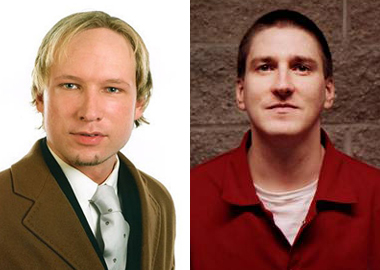The similarities between suspected mass killer Anders Behring Breivik and Oklahoma City bomber Timothy McVeigh are striking.
Both were good-looking young white men, self-enlisted soldiers in an imagined cosmic war to save Christendom. Both thought their acts of mass destruction would trigger a great battle to rescue society from the liberal forces of multiculturalism that allowed non-Christians and non-whites positions of acceptability. Both regretted the loss of life but thought their actions were “necessary.” For that they were staunchly unapologetic. And both were Christian terrorists.
Their similarities even extend to the kind of explosive used in their actions. Both used a mixture of fuel oil and ammonium nitrate fertilizer; which Breivik said he needed for his farm operations. The farm, it turned out, was rented largely because it was a convenient place to test his car bombs.
And then there is the matter of dates. McVeigh was fixed on the day of April 19, the anniversary of the Waco siege. Breivik chose July 22, which was the day in 1099 that the Kingdom of Jerusalem was established during the First Crusades.
The title of Breivik’s manifesto, which was posted on the internet on that day, is “2083”—the date Breivik suggested would be the culmination of a 70-year war that began with his action. Yet 70 years from 2011 would be 2081; why did he date the final purge of Muslims from Norway to be two years later, in 2083? I found the answer on page 242 of Breivik’s manifesto, where he explains that on 1683 at the Battle of Vienna, the Ottoman Empire’s military was defeated in a protracted struggle, thereby insuring that most of Europe would not become part of the Muslim empire. The date in Breivik’s title is the 400th anniversary of that decisive battle, and in Breivik’s mind he was re-creating the historic efforts to save Europe from what he imagined to be the evils of Islam.
The threat of Islam is a dominant motif of his 1500-page manifesto, “2083: A European Declaration of Independence.” The writing of a manifesto is a major difference between Breivik and McVeigh, who was not a writer; instead McVeigh copied and quoted from his favorite book, The Turner Diaries, a novel by neo-Nazi William Luther Pierce under the pseudonym Andrew Macdonald.
McVeigh’s beloved novel explains his motives in a matter eerily similar to the writings of Breivik in his “2083” manifesto: he thought that liberal politicians had given in to the forces of globalization and multiculturalism, and that the “mudpeople” (non-white, non-Christian, non-heterosexual, non-patriarchal males) were trying to take over the country. To save the country for Christendom the righteous white, straight, non-feminist Christian males had to be shocked into reality by the force of an explosion that would signal to them that the war had begun. These were McVeigh’s ideas from The Turner Diaries, but they were also Breivik’s.
“The time for dialogue is over,” Breivik writes on page 811 of his manifesto. “The time for armed resistance has come.”
The enemy of this imagined cosmic war were “the cultural Marxist/multiculturalist elites” whom he regarded as the “Nazis of our time,” intent on “leading us [White Europeans] to the cultural slaughterhouse by selling us into Muslim slavery.” Breivik says, threateningly, to the “multiculturalist elite” that “we know who you are, where you live and we are coming for you.”
The manifesto is an interesting and eclectic document, something of a scrapbook of everything from his instructions for small-scale farming to a syllabus for a course on revolution that he’d love to see taught (complete with extensive bibliography that includes authors such as Immanuel Wallerstein, Theda Skocpol, and Eric Hobsbawm; it recommends as a textbook Theorizing Revolution, a book written by my colleague at Santa Barbara, John Foran). It also includes theoretical and historical overviews of European history and political ideas, and an attempt to explain Muslim ideas and Islamic history; skewed in such a way to make it appear as if this major religious tradition were a single ideology eager to control the world.
The manifesto also includes a how-to manual for the creation of terrorist devices and acts of terrorism themselves—a manual not unlike the “Army of God” handbook created by Christian anti-abortion activists, most likely penned by Lutheran pastor Michael Bray. It advises on costumes that might be worn in order to avoid detection (including a policeman’s uniform).
Perhaps the most interesting section is Breivik’s day-by-day accounts of the weeks preceding the July 22 bombing and massacre, a chronology that ends with this matter-of-fact statement: “I believe this will be my last entry. It is now Fri July 22nd, 12.51.”
Moments later he posted the 1500-page book on the website before allegedly driving to downtown Oslo to detonate the bomb that killed seven and shattered major buildings containing the offices of the ruling political party. Afterward, he reportedly donned the policeman’s uniform to gain entrance to the liberal party’s youth camp where he coldly murdered over 80 of the young people in a rampage that lasted more than an hour.
Like McVeigh, he thought that this horrible dramatic action would bring a hidden war into the open. Like many modern terrorists, his violent act was a form of performance violence, a symbolic attempt at empowerment to show the world that for the moment he was in charge. The terrorist act was a wake-up call, and a signal that the war had begun.
Behind the earthly conflict was a cosmic war, a battle for Christendom. As the title of Breivik’s manifesto indicates, he thought he was re-creating that historical moment in which Christianity was defended against the hordes, and Islam was purged from what he imagined to be the purity of European society.
Breivik meticulously detailed what he expected to be the historical trajectory of this war through four stages, culminating in 2083. He expected that the forces of multiculturalism would be tough, and would resist the efforts to combat it. “It will take us up to 70 years to win,” Breivik writes on page 811, but adds that “there is no doubt in our minds that we will eventually succeed.”
In the final phase, the civil war between the evil multiculturalists and the righteous few, a series of coup d’etats throughout Europe will overthrow the liberal forces. Then, finally “the deportation of Muslims” will begin, and European Christendom will be restored.
Is this a religious vision, and am I right in calling Breivik a Christian terrorist? It is true that Breivik—and McVeigh, for that matter—were much more concerned about politics, race, and history than about scripture and religious belief; with Breivik even going so far as to write that “It is enough that you are a Christian-agnostic or a Christian atheist (an atheist who wants to preserve at least the basics of the European Christian cultural legacy (Christian holidays, Christmas and Easter)).”
But much the same can be said about Osama bin Laden, Ayman al-Zawahiri, and many other Islamist activists. Bin Laden was a businessman and engineer, and Zawahiri was a medical doctor; neither were theologians or clergy. Their writings show that they were much more interested in Islamic history than theology or scripture, and imagined themselves as re-creating glorious moments in Islamic history in their own imagined wars. Tellingly, Breivik writes of al Qaeda with admiration, as if he would love to create a Christian version of their religious cadre.
If bin Laden is a Muslim terrorist, Breivik and McVeigh are surely Christian ones. Breivik was fascinated with the Crusades and imagined himself to be a member of the Knights Templar, the crusader army of a thousand years ago. But in an imagined cosmic warfare time is suspended, and history is transcended as the activists imagine themselves to be acting out timeless roles in a sacred drama. The tragedy is that these religious fantasies are played out in real time, with real and cruel consequences.





